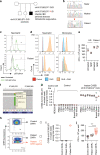Somatic mosaicism and common genetic variation contribute to the risk of very-early-onset inflammatory bowel disease
- PMID: 32081864
- PMCID: PMC7035382
- DOI: 10.1038/s41467-019-14275-y
Somatic mosaicism and common genetic variation contribute to the risk of very-early-onset inflammatory bowel disease
Erratum in
-
Author Correction: Somatic mosaicism and common genetic variation contribute to the risk of very-early-onset inflammatory bowel disease.Nat Commun. 2022 Jun 22;13(1):3576. doi: 10.1038/s41467-022-31010-2. Nat Commun. 2022. PMID: 35732629 Free PMC article. No abstract available.
Abstract
Very-early-onset inflammatory bowel disease (VEO-IBD) is a heterogeneous phenotype associated with a spectrum of rare Mendelian disorders. Here, we perform whole-exome-sequencing and genome-wide genotyping in 145 patients (median age-at-diagnosis of 3.5 years), in whom no Mendelian disorders were clinically suspected. In five patients we detect a primary immunodeficiency or enteropathy, with clinical consequences (XIAP, CYBA, SH2D1A, PCSK1). We also present a case study of a VEO-IBD patient with a mosaic de novo, pathogenic allele in CYBB. The mutation is present in ~70% of phagocytes and sufficient to result in defective bacterial handling but not life-threatening infections. Finally, we show that VEO-IBD patients have, on average, higher IBD polygenic risk scores than population controls (99 patients and 18,780 controls; P < 4 × 10-10), and replicate this finding in an independent cohort of VEO-IBD cases and controls (117 patients and 2,603 controls; P < 5 × 10-10). This discovery indicates that a polygenic component operates in VEO-IBD pathogenesis.
Conflict of interest statement
The authors have made the following disclosures: C.A.A. has received consultancy fees from Genomics plc and Illumina. H.H.U. received collaborative research support or consultancy fees from Eli Lilly, UCB Pharma, Celgene, Regeneron, Boehringer Ingelheim, Pfizer, and AbbVie. SPT has been adviser to, in receipt of educational or research grants from, or invited lecturer for AbbVie, Amgen, Asahi, Biogen, Boehringer Ingelheim, BMS, Cosmo, Elan, Enterome, Ferring, FPRT Bio, Genentech/Roche, Genzyme, Glenmark, GW Pharmaceuticals, Immunocore, Immunometabolism, Janssen, Johnson & Johnson, Lilly, Merck, Novartis, Novo Nordisk, Ocera, Pfizer, Shire, Santarus, SigmoidPharma, Synthon, Takeda, Tillotts, Topivert, Trino Therapeutics with Wellcome Trust, UCB Pharma, Vertex, VHsquared, Vifor, Warner Chilcott, and Zeria. The remaining authors declare no competing interests.
Figures



References
-
- Peloquin JM, Goel G, Villablanca EJ, Xavier RJ. Mechanisms of pediatric inflammatory bowel disease. Annu. Rev. Immunol. 2016;34:31–64. - PubMed
-
- Molodecky NA, et al. Increasing incidence and prevalence of the inflammatory bowel diseases with time, based on systematic review. Gastroenterology. 2012;142:46–54.e42. - PubMed
-
- Cosnes J, Gowerrousseau C, Seksik P, Cortot A. Epidemiology and natural history of inflammatory bowel diseases. Gastroenterology. 2011;140:1785–1794. - PubMed
-
- Benchimol EI, et al. Epidemiology of pediatric inflammatory bowel disease: a systematic review of international trends. Inflamm. Bowel Dis. 2011;17:423–439. - PubMed
Publication types
MeSH terms
Substances
Grants and funding
- P30 DK034854/DK/NIDDK NIH HHS/United States
- MR/J00314X/1/MRC_/Medical Research Council/United Kingdom
- MR/S036377/1/MRC_/Medical Research Council/United Kingdom
- MC_UU_00008/7/MRC_/Medical Research Council/United Kingdom
- C0482/MRF_/MRF_/United Kingdom
- R01 DK123530/DK/NIDDK NIH HHS/United States
- MR/M00533X/1/MRC_/Medical Research Council/United Kingdom
- RC2 DK118640/DK/NIDDK NIH HHS/United States
- MC_UU_12010/7/MRC_/Medical Research Council/United Kingdom
- G0800675/MRC_/Medical Research Council/United Kingdom
- U01 DK062420/DK/NIDDK NIH HHS/United States
- U01 DK062431/DK/NIDDK NIH HHS/United States
- 109965/Z/15/Z/WT_/Wellcome Trust/United Kingdom
- NIHR-RP-R3-12-026/DH_/Department of Health/United Kingdom
LinkOut - more resources
Full Text Sources
Miscellaneous

